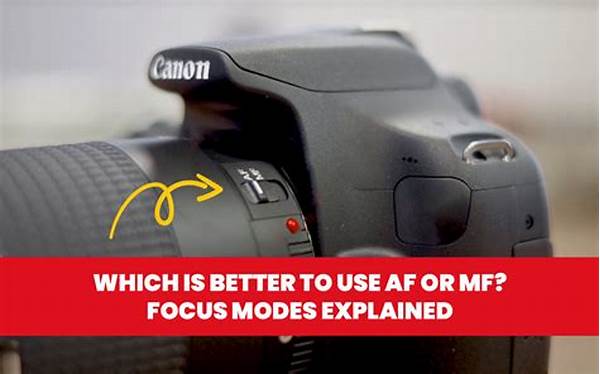Hey there, fellow photography enthusiasts! Today we’re diving into a topic that many of us grapple with—getting that sharp shot of a moving subject. Whether it’s your pet dashing across the lawn or your best friend nailing a skateboarding trick, capturing a crisp image can be challenging. But fear not! We’re going to unravel the mysteries of camera focus modes for moving subjects. Let’s bring some clarity to your shots, one focus mode at a time!
Read Now : Creative Photo Design Applications
Understanding Camera Focus Modes
Before we get into the specifics of camera focus modes for moving subjects, let’s lay down the basics. Autofocus, which is the star of the show today, is typically divided into three modes: Single Shot (AF-S or One Shot), Continuous (AF-C or AI Servo), and Automatic (AF-A or AI Focus). For those of you who only occasionally shoot moving subjects, the Automatic mode might feel like a safe bet, but here’s the catch—it doesn’t always keep up with the pace of your subject. On the other hand, Continuous mode is often your best friend for tracking motion. It’s like having a personal assistant keeping an eye on your subject as it makes its move. Knowing which mode works best for which situation can make all the difference in the world!
When diving into camera focus modes for moving subjects, consider the type of movement you’re trying to capture. If your subject is moving erratically, Continuous mode allows your camera to adjust focus dynamically, tracking the movement and making minute adjustments to maintain clarity. For straight-line movement, consider experimenting with back-button focusing—an underrated gem that many experienced photographers swear by. This approach can give you more control and consistency in those fast-paced shooting scenarios.
Now, don’t let all these terms intimidate you! Playing around with settings and modes is all part of the photography journey. Experimentation helps you understand how your camera reacts in various situations, leading to better shots over time. Mastering camera focus modes for moving subjects is less about perfection on your first try and more about discovering what settings bring out the best in your photography style.
Tips for Better Focus
1. Pre-emptive Focus: Anticipate where the subject will be in your frame, and start focusing before they enter the critical zone. This proactive approach helps in maintaining sharpness.
2. Use AI or AF Tracking Systems: Modern cameras come with specialized tracking systems. Enable these to assist in following unpredictable movements, smoothing out your photographic workflow.
3. Single-Point vs Dynamic AF Area: Here’s the scoop—single-point focus offers precision for stationary subjects. Switch to dynamic for erratic movement and give your camera the flexibility it needs.
4. Pan with the Subject: Move your camera along with the subject. This technique not only keeps your subject centered but also helps in reducing motion blur.
5. Continuous Shooting Mode: It’s not just about focus but also about timing. Burst mode captures several frames in quick succession, increasing your chances of getting that one perfect shot.
Choosing the Right Camera Settings
Let’s be honest—camera settings can feel like a maze. However, choosing the right camera focus modes for moving subjects can make a world of difference. Start with the appropriate shutter speed. Fast action? Opt for at least 1/1000s to ensure a crisp capture. Pair your speedy shutter with an appropriate aperture. A wider aperture (like f/2.8) allows more light, which helps in freezing action even in challenging lighting conditions.
Furthermore, don’t shy away from dialing up that ISO. In some cases, you might need to prioritize capturing a sharp image over minimizing noise. Modern cameras cope quite well with higher ISOs without sacrificing too much image quality. Explore your camera’s dynamic range capabilities, and you’ll notice how your images retain details in both highlights and shadows, even at high ISO levels.
Another crucial setting is the metering mode. Spot metering can be particularly useful when your subject is backlit or moving across areas with varying light levels. It gives you more consistent exposures, ensuring your subject is perfectly illuminated against diverse backgrounds. These settings, combined with the ideal focus mode, round out your toolkit for tackling any fast-paced shooting scenario.
Real-World Application Tactics
1. Look Ahead: In dynamic environments like sports or wildlife photography, try predicting movement patterns. It helps prepare your focus system in advance.
2. Zone Focusing: When dealing with unpredictable subjects, set a zone where you expect action. Once in the zone, your camera maintains accurate focus.
3. Utilize Auto ISO: Many modern cameras have excellent auto ISO functionality that lets you focus on composition rather than constant adjustments.
4. Fine Tune AF Settings: If your camera allows it, customize your AF settings based on the specific type of motion.
Read Now : Optimize Lighting For Great Photos
5. Use Manual Override: Sometimes, manual adjustments mid-shoot help refine focus, especially in complex lighting or fast movement.
6. Upgrade Lenses: Fast lenses with wide apertures provide better performance tracking moving subjects than standard kit lenses.
7. Refine Panning Techniques: Panning not only keeps the subject in frame but can also result in creative shots with blurred backgrounds.
8. Fast Memory Cards: Ensure you’re using high-speed memory cards capable of keeping up with continuous shooting modes to prevent buffering delays.
9. Practice Predictive Focus: Familiarize yourself with your camera’s ability to predict where the subject will go, especially in irregular movements.
10. Test in Controlled Settings: Practice in a predictable environment to fine-tune your techniques before heading to more dynamic situations.
Mastering Focus Techniques for Action Shots
Alright, let’s chat about the artistry behind camera focus modes for moving subjects. There’s something uniquely thrilling about nailing that perfect action shot. When you finally see a sharp image of a runner mid-stride or a bird in flight with its wings elegantly poised—it feels like magic. But let’s get real, folks—it’s not just luck, it’s knowing your gear!
Your camera is equipped with some pretty powerful tools. For action photographers, one of the secret weapons is the continuous autofocus mode. This nifty feature isn’t just good at tracking subjects; it’s brilliant at guessing where they’ll be next, using complex algorithms to keep things sharp. It’s like having a tiny AI assistant inside your lens, ensuring you don’t miss the defining shot of the day.
Sometimes, practice truly does make perfect. Heading out to a local sports event or setting up a backyard bird-watching station can do wonders for your technique. Whatever the subject, practicing helps you anticipate moments before they unfold, giving you that edge in timing. All this real-time experience transforms your camera into more than just a gadget—it becomes an extension of your creative vision.
Don’t Sweat the Small Stuff
When tackling the adventurous world of camera focus modes for moving subjects, remember to embrace the process. Sure, it can be tricky to get everything right on your first go, but each miss is a learning curve, each blurred frame is a stepping stone. With every click, you’re educating your finger to be more intuitive and your eyes to be more perceptive. So, whether you’re aiming to capture a ballet of motions or the swift run of an athlete, staying chill goes a long way in honing those quick reflexes.
In the photography game, everyone finds their groove differently. It might feel like everyone else nails it on the first try—but remember, they’re probably editing out their bloopers too! Give yourself the permission to experiment, feel the stumbles, and ultimately, celebrate your wins. The more time you spend with your camera, particularly when focusing on action shots, the more naturally you’ll start predicting your subjects’ next moves.
Wrapping It All Up
When it comes to capturing life’s motion, mastering camera focus modes for moving subjects is an ongoing adventure. You’re armed with a plethora of options to explore—from continuous focus modes to wide apertures and beyond. Dive into this world of possibilities with gusto, experiment like there’s no tomorrow, and evolve your skills with each new endeavor.
Incorporating these tips and techniques helps refine your photography skills over time. You start appreciating nuances you might have overlooked before, and that’s when the magic happens. So, keep experimenting with these focus modes and watch as your ability to photograph motion gets sharper and more compelling. Snap away, and soon, you’ll find those dynamic shots becoming a thing of beauty, leaving you nothing short of a photographic storyteller.



